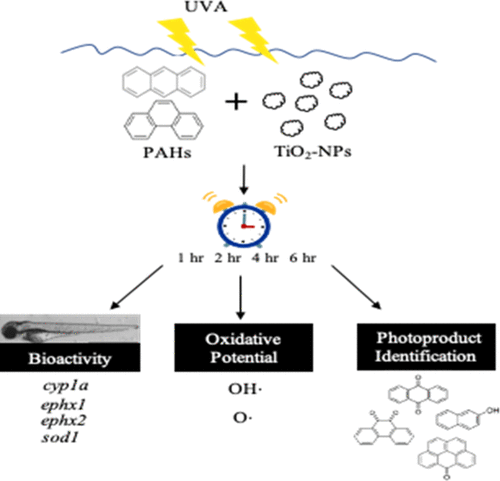当前位置:
X-MOL 学术
›
Environ. Sci. Technol.
›
论文详情
Our official English website, www.x-mol.net, welcomes your
feedback! (Note: you will need to create a separate account there.)
Time-Related Alteration of Aqueous-Phase Anthracene and Phenanthrene Photoproducts in the Presence of TiO2 Nanoparticles
Environmental Science & Technology ( IF 10.8 ) Pub Date : 2021-03-02 , DOI: 10.1021/acs.est.0c07488 Lindsey St Mary 1 , Lisandra S D Trine 2 , Courtney Roper 2, 3 , Jackson Wiley 2 , Staci L Massey Simonich 2 , Martin McCoustra 4 , Theodore B Henry 1
Environmental Science & Technology ( IF 10.8 ) Pub Date : 2021-03-02 , DOI: 10.1021/acs.est.0c07488 Lindsey St Mary 1 , Lisandra S D Trine 2 , Courtney Roper 2, 3 , Jackson Wiley 2 , Staci L Massey Simonich 2 , Martin McCoustra 4 , Theodore B Henry 1
Affiliation

|
Polycyclic aromatic hydrocarbons (PAHs) and titanium dioxide (TiO2) nanoparticles (NPs) are photoactive environmental pollutants that can contaminate aquatic environments. Aqueous-phase interactions between PAHs and TiO2–NPs are of interest due to their emerging environmental relevance, particularly with the deliberate application of TiO2–NPs to remediate pollution events (e.g., oil spills). Our objective was to investigate anthracene (ANT) and phenanthrene (PHE) photoproduct formation and transformation following ultraviolet A (UVA) irradiation in the presence and absence of TiO2–NPs. ANT and PHE solutions were prepared alone or in combination with TiO2–NPs, UVA-irradiated, and either exposed to larval zebrafish or collected for chemical analyses of diverse hydroxylated PAHs (OHPAHs) and oxygenated PAHs (OPAHs). The expression profiles of genes encoding for enzymes involved in PAH metabolism showed PAH-specific and time-dependent inductions that demonstrated changes in PAH and photoproduct bioavailability in the presence of TiO2–NPs. Chemical analyses of PAH/NP solutions in the absence of zebrafish larvae identified diverse photoproducts of differing size and ring arrangements, which suggested photodissociation, recombination, and ring re-arrangements of PAHs occurred either during or following UVA irradiation. Both ANT and PHE solutions showed heightened oxidative potential following irradiation, but TiO2–NP-related increases in oxidative potential were PAH-specific. The exploitation of multiple analytical methods provided novel insights into distinct PAH photoactivity, TiO2–NP influence on photoproduct formation in a PAH-specific manner, and the significant role time plays in photochemical processes.
中文翻译:

TiO2 纳米粒子存在下水相蒽和菲光产物的时间相关变化
多环芳烃 (PAH) 和二氧化钛 (TiO 2 ) 纳米颗粒 (NP) 是可污染水生环境的光活性环境污染物。PAH 和 TiO 2 –NP之间的水相相互作用因其新兴的环境相关性而受到关注,特别是在故意应用 TiO 2 –NP 来修复污染事件(例如,石油泄漏)时。我们的目标是研究在存在和不存在 TiO 2 –NP 的情况下,紫外线 A (UVA) 照射后蒽 (ANT) 和菲 (PHE) 光产物的形成和转化。ANT 和 PHE 溶液单独制备或与 TiO 2结合制备–NPs,UVA 照射,暴露于斑马鱼幼虫或收集用于各种羟基化 PAHs (OHPAHs) 和含氧 PAHs (OPAHs) 的化学分析。编码参与 PAH 代谢的酶的基因表达谱显示了 PAH 特异性和时间依赖性诱导,证明了在 TiO 2 –NP 存在的情况下 PAH 和光产物生物利用度的变化。在没有斑马鱼幼虫的情况下对 PAH/NP 溶液的化学分析确定了不同大小和环排列的多种光产物,这表明在 UVA 照射期间或之后发生了 PAH 的光解离、重组和环重新排列。ANT 和 PHE 溶液在照射后均显示出更高的氧化电位,但 TiO 2–NP 相关的氧化电位增加是 PAH 特异性的。多种分析方法的开发为不同的 PAH 光活性、TiO 2 –NP 以 PAH 特异性方式对光产物形成的影响以及时间在光化学过程中的重要作用提供了新的见解。
更新日期:2021-03-16
中文翻译:

TiO2 纳米粒子存在下水相蒽和菲光产物的时间相关变化
多环芳烃 (PAH) 和二氧化钛 (TiO 2 ) 纳米颗粒 (NP) 是可污染水生环境的光活性环境污染物。PAH 和 TiO 2 –NP之间的水相相互作用因其新兴的环境相关性而受到关注,特别是在故意应用 TiO 2 –NP 来修复污染事件(例如,石油泄漏)时。我们的目标是研究在存在和不存在 TiO 2 –NP 的情况下,紫外线 A (UVA) 照射后蒽 (ANT) 和菲 (PHE) 光产物的形成和转化。ANT 和 PHE 溶液单独制备或与 TiO 2结合制备–NPs,UVA 照射,暴露于斑马鱼幼虫或收集用于各种羟基化 PAHs (OHPAHs) 和含氧 PAHs (OPAHs) 的化学分析。编码参与 PAH 代谢的酶的基因表达谱显示了 PAH 特异性和时间依赖性诱导,证明了在 TiO 2 –NP 存在的情况下 PAH 和光产物生物利用度的变化。在没有斑马鱼幼虫的情况下对 PAH/NP 溶液的化学分析确定了不同大小和环排列的多种光产物,这表明在 UVA 照射期间或之后发生了 PAH 的光解离、重组和环重新排列。ANT 和 PHE 溶液在照射后均显示出更高的氧化电位,但 TiO 2–NP 相关的氧化电位增加是 PAH 特异性的。多种分析方法的开发为不同的 PAH 光活性、TiO 2 –NP 以 PAH 特异性方式对光产物形成的影响以及时间在光化学过程中的重要作用提供了新的见解。











































 京公网安备 11010802027423号
京公网安备 11010802027423号